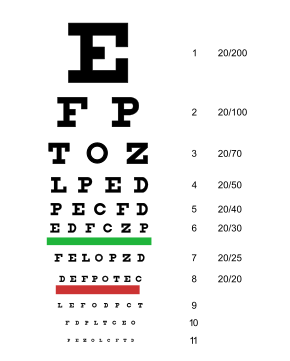A vision screening is a simple test that can be done in the office of your PCP or with school age children by the school nurse. Vision screenings are intended to identify children or adults who may have undetected vision problems. A vision screening cannot diagnose exactly what is wrong with your eyes, but it can indicate that you should make an appointment for a more comprehensive eye exam.
A comprehensive exam is done by an Optometrist, a healthcare professional who provides primary vision care ranging from sight testing and correction, to the diagnosis, treatment, and management of vision changes. An Ophthalmologist will also do a comprehensive eye exam, in addition an Ophthalmologist will also perform eye surgery or focus on being a specialist in one disease or another such as Glaucoma, or will focus on research studies. Usually a patient will see am Ophthalmologist on the recommendation of their Optometrist
A comprehensive eye exam can take an hour or more depending on the doctor and the number and complexity of test required to fully evaluate your vision and health of your eyes.
Some of the tests required for a full evaluation of your eye health:
- Visual Acuity Test – used to measure the sharpness of your vision.
- Color Blindness Test
- Cover Test – used to check eye alignment
- Ocular Motility Testing – to determine how well your eyes can follow a moving object.
- Stereopsis Test – Depth perception and 3-dimensional nature of objects
- Retinoscopy – This test estimates which lens powers will best correct your distance vision.
- Refraction – This test is used to exactly determine eyeglass prescription by putting a phoropter in front of your eyes and with a series of lens choices to fine-tune the lens power you need.
- Slit Lamp Exam-used to examine the structures of your eye under high magnification.
- The Glaucoma Test-measures the pressure in your eyes (puff-of-air test). It is based on your eyes resistance to the puff-of-air. The NCT (Non-contact tonometry) calculates (IOP) Intraocular pressure.
- Pupil Dilation-This allows a better view of the eyes internal structures.
- Visual Field Test- to check for possible blind spots in peripheral or side vision.
More Eyecare doctors are including some type of wellness retinal scan such as Optos to the comprehensive exam. Retinal imaging offers a better view using a high-resolution imaging system to take pictures of the inside of the eye. This helps doctors to assess the health of the retina. Some of the diseases retinal imaging can help to detect:
- AMD (Age-related Macular Degeneration)
- Some Cancers
- Diabetic Retinopathy
- Glaucoma
- Hypertension
- Retinal Detachment
Sources:
Image:
https://en.wikipedia.org/wiki/Eye_examination

